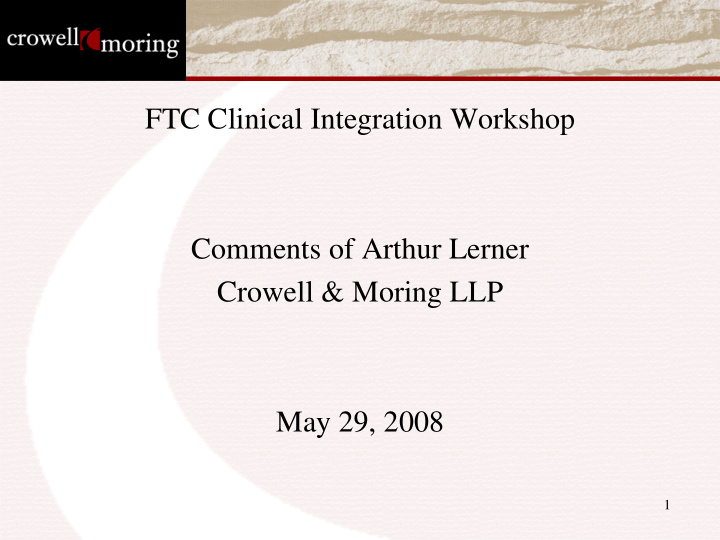



FTC Clinical Integration Workshop Comments of Arthur Lerner Crowell & Moring LLP May 29, 2008 1
Baseline • Clinical integration has tremendous potential • It may be very hard • Where it’s going very well may not often be in the line of sight for outside antitrust counsel • Or there may not be a lot of significant clinical integration activity outside context of “at risk” organizations • There is a great deal of interest • When integration initiative is robust and connected well to joint negotiation, and market power worries absent, antitrust shouldn’t be an obstacle. But these conditions not always present. 2
Watching out for “ancillary integration” • Is the restraint ancillary to the efficiency- enhancing integration? • Or is the restraint primary, and the integration ancillary? • “How much integration do we need to do so we can negotiate price?” 3
Expecting that price negotiation will increase rates? • Should providers participating in clinical integration expect to be “rewarded” for such participation? – Presumably through joint negotiations for higher prices – If providers do not have market power, then enhanced compensation should only reflect added value to payors – Implicit assumption, sometimes, appears to be that reward will be greater than that 4
Should “ancillary-ness” be rebuttable presumption? • Would put much heavier pressure on “how much is enough” question • Would put market definition and market power issues to the test much more often 5
Rewarding achieved value or rewarding integration • Will marketplace focus compensation recognition on – – Measurable benchmarks of patient outcomes, quality improvement or cost savings? – Achievement of clinical integration measures? • Is the latter a proxy or early indicator of the former? 6
Is there a market failure angle? • Reimbursement system typically pays same level of compensation irrespective of quality or efficiency of service • Long-term nature of savings from integration investment may dull incentives of payors to fund integration activities • One claim is that joint price setting is ancillary to clinical integration simply because it enables providers to get the money needed to pay for the integration • This argument is troubling – first it seems to imply market power, and second because it implies that price- fixing can be appropriate response to the market’s failure to “adequately” pay for any of various socially beneficial activities. • It moves antitrust into social policy arena, in which collusion would be justified so long as proceeds are used in manner deemed socially or economically beneficial 7
Recommend
More recommend